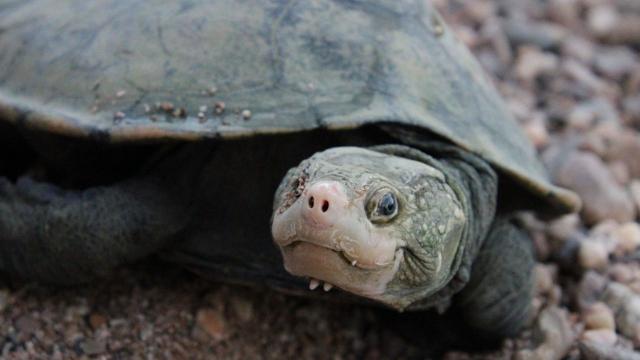Behold, the “bum-breathing” Irwin’s turtle, a breed of turtle that has been rediscovered in river systems it was thought to have previously left.
Known by scientists as the Irwin’s turtle, we’re over the moon that the butt-breather has returned to show us how it is done.
The species was first discovered in the 1990s by Steve and Bob Irwin (Steve’s Dad) in the Burdekin catchment, which is located in far north Queensland.
For a long time, the presence of the Irwin’s Turtle in the Burdekin catchment was elusive.
In fact, scientists didn’t actually think that the turtle was still living in the Burdekin catchment, and the presence of the Irwin’s turtle hasn’t been formally recorded in this area in more than 25 years.
Since the construction of a dam at the Burdekin catchment, its only known habitat was a 25 kilometre stretch inland from Mackay, where a dam is currently being proposed. It was thought that the turtle left the Burdekin area due to a change in water conditions.
“Until this rediscovery, we didn’t have any formal records to prove that the Irwin’s turtle was still living in the lower Burdekin River, and that river has changed a lot since the construction of the Burdekin Falls Dam,” says Professor Damien Burrows, the director of the Centre for Tropical Water and Aquatic Ecosystem Research.
“It’s reassuring to know they are still living there.”
So, just quickly, about the whole “bum-breathing” thing? It’s actually a pretty common thing among aquatic animals. The ability to breathe through the cloaca (the butt of the turtle) is something that we’ve observed in a range of other animals, but it’s actually something you’ll find in some turtle species in particular. Who doesn’t love turtles?
Anyway, back to the Irwin turtle in particular, researchers were able to make the rediscovery through three survey periods between 2020 and 2021, investigating 37 different survey sites and utilising eDNA technology.
“Previously, it’s been very difficult to sample for the Irwin’s turtle because they only live in places where there are crocodiles, or in upland tributaries which are very hard to access,” added Burrows.
“They also don’t come into traps easily and the water they are living in, in the Burdekin isn’t clear so you can’t put in underwater cameras to see them.
“But now with eDNA, all we had to do was take a water sample and analyse for their DNA.”
This means that scientists can investigate areas where they reckon the elusive Irwin’s turtle could be hanging out without having to capture one. Now, researchers can get all their answers from the soil, sediment and water, though the age of turtles and population density isn’t something that this method can reveal.
“This rediscovery has now challenged the previous hypothesis that the species could not survive in these conditions,” added Doctor Cecilia Villacorta-Rath.
“We don’t know anything about the demographics of this population, but the fact we have found their eDNA now, despite the dam being built in the 1980s, could point to adult Irwin’s turtles being able to survive in these more turbid water conditions.”
This research will go towards assisting the state government with the upcoming dam proposal at Urannah station.
Hell yeah Irwin’s turtle, you go you funky little animal.
